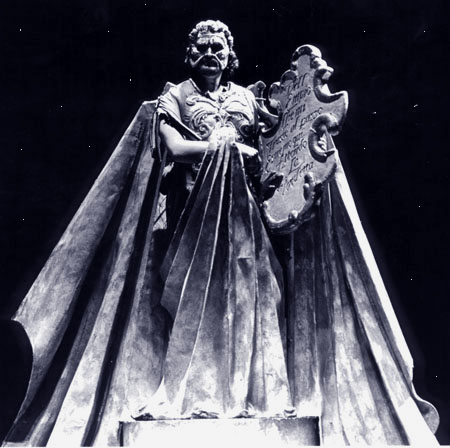Michelangelo spoke of the form living within the marble and it was up to him to release the statue.
In many cultures man was fashioned by the gods out of clay and the artist does the same as he brings forth his own creation. From pieces of stone, clay and molten metals images arise that have inspired mankind for thousands of years. To be able to touch and caress the textures of a statue evokes the feeling of a search for the spirit within. Perhaps we seek to see if life does exist in the image which fills our imagination with longing, questions, sometimes empathy and often awe.
Don Giovanni and the Stone Guest
Don Giovanni is set in Seville in the mid-17th Century. In the beginning Don Giovanni attempts to seduce Donna Anna. Her father, the Commendatore enters and challenges the Don to a duel and is killed. After several hours of the Don attempting to seduce others he is eventually hunted and takes refuge in a graveyard and laughingly relates his recent sins. A ghostly voice is heard warning that his mirth will soon end. A statue of the Commendatore appears and is inscribed with a vow of vengeance on his murderer. Don Giovanni brazenly invites the statue to supper. The statue accepts. At supper in his dining room Donna Elvira bursts in and begs the Don to change his ways, but he merely invites her to eat. As she leaves, she suddenly screams, and runs out. The Don orders his servant Leporello to go and see what was there. Leporello returns stammering about a man of stone knocking at the door. The Commendatore's statue appears and announces that he has come for supper. The Don offers his hospitality but the statue refuses mortal food, but invites Don Giovanni to sup with him. The Don accepts, giving the statue his hand as a promise, but finds himself trapped. The statue demands that Don Giovanni repent, but he refuses, and is dragged screaming off to Hell as a chorus of demons condemn him.
Wolfgang Amadeus Mozart
 Sculpture goes back to Prehistoric times where Stone Age statuettes were made of ivory or soft stone, however some clay human and animal figures have been found from as far back as 30,000 - 25,000 BC. Many of the known examples of the earliest statues were of the plump mother goddess, respected for fertility by our earliest ancestors. In Sumeria, Akkadia and Babylonia much use was made of basalt, diorite, sandstone and alabaster. Copper, gold, silver, shells and precious stones were used for sculpture and inlays. Clay was used for pottery and terra cotta sculpture. Stone was rare in the near East and had to be imported. The statues were known for the large, staring eyes, and long beards on the men. One of the earliest examples of Egyptian sculpture is the make-up Palette of King Narmer, from 3100 BC. From this period on the development of sculpture progressed along strict religious lines and the examples of fine miniature work is just a precious as the colossal statues of Ramsis as seen at Abu Simbel and elsewhere. To decorate the statues gold was imported from Nubia, precious stones and pigments came from as far away as Afganitan.
Sculpture goes back to Prehistoric times where Stone Age statuettes were made of ivory or soft stone, however some clay human and animal figures have been found from as far back as 30,000 - 25,000 BC. Many of the known examples of the earliest statues were of the plump mother goddess, respected for fertility by our earliest ancestors. In Sumeria, Akkadia and Babylonia much use was made of basalt, diorite, sandstone and alabaster. Copper, gold, silver, shells and precious stones were used for sculpture and inlays. Clay was used for pottery and terra cotta sculpture. Stone was rare in the near East and had to be imported. The statues were known for the large, staring eyes, and long beards on the men. One of the earliest examples of Egyptian sculpture is the make-up Palette of King Narmer, from 3100 BC. From this period on the development of sculpture progressed along strict religious lines and the examples of fine miniature work is just a precious as the colossal statues of Ramsis as seen at Abu Simbel and elsewhere. To decorate the statues gold was imported from Nubia, precious stones and pigments came from as far away as Afganitan.
All free-standing sculpture in the Golden Age of Greece was public art and many sculptors became international celebrities. The most renowned was Pheidias who created the gigantic forty foot high gold and ivory statue of Athena in full armour for the interior of the Parthenon, and one of the seven Ancient Wonder’s, the gold statue of Zeus in the sanctuary at Olympia. Both these enormous wonders have been lost to history but he is also said to have worked on the frieze on the Parthenon which does remain as the controversial Elgin Marbles in Britain.
Perhaps one of the greatest expressions of love was the creation of over two thousand statues of a beautiful boy Antinous within a few years of his death. Statues for veneration were spread throughout the entire Roman World. He was loved by the Emperor Hadrian and at the age of eighteen he mysteriously died while travelling on the Nile. Such was Hadrians devotion that it led to led to his immediate deification. He was to be the last of the Roman Gods. There is much more on Antinous elsewhere on this site.
Sculpture in Flesh - The Human Statue







No comments:
Post a Comment
Comment here or in side bar or you can email me at pepispictures@gmail.com